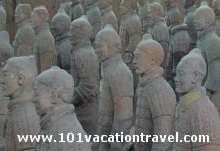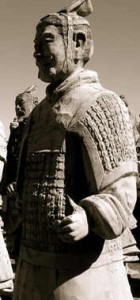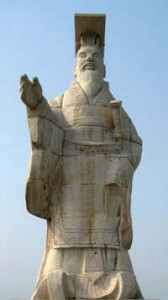Terra-Cotta Army in China (China’s Clay Army)
 Discovery of Terra-Cotta Army
Discovery of Terra-Cotta Army
On a sunny afternoon, a group of Chinese villagers were working hard drilling water well. Instead of water, they found earthenware heads of life-sized soldiers. Soon the well diggers were replaced by archeologists in this maize field near Xian (pronounced as “She An”), Shaanxi Province. To archeologist amazement, human size terra-cotta warriors, standing row upon row beneath the maize field were unearthed. That was in 1974.
 Terra-Cotta Soldiers-Guardian to the First Emperor of China
Terra-Cotta Soldiers-Guardian to the First Emperor of China
This life-sized clay army, discovered standing in columns of four, forming a parallel corridors are guarding the tomb of the First Emperor in China, Qin Shi Huang (259 BC – 210 BC) in his after life. Emperor Qin united China from previously divided lands under rulings by five other states, Zhao, Han, Wei, Yan, Qi and conferred the title ‘Emperor’ on himself.
Currently 3 pits containing over 8000 terra-cotta soldiers, 130 chariots, 520 horses have been unearthed in the east of Hill Lishan. All terra-cotta soldiers were sculpted in great details and in different facial expressions. No two faces are the same. So far, 24 different types of mustaches and a rich variety of headdresses are noted. Horses were sculpted with their mouth open, giving strong impression of untamed power. There was legend that terra-cotta soldiers were real warriors, buried alive with their King to protect him from any danger in his after life.
Today we see Qin terra-cotta in pale grey color. Originally, army were painted in various colors of green red, black, white, yellow and brown. The color were made from mineral and oxidized at the contact of air.
 The Mausoleum Of Qin Shi Huang
The Mausoleum Of Qin Shi Huang
Study suggested the current unearthed terra-cotta pits is the outer borders of Emperor Qin’s burial mound. Historical record had suggested that the gigantic mausoleum started building in 246 BC when Emperor Qin was 13 years old, and labored more than 700,000 men to complete the construction. Palaces, scenic towers, precious jewelry, ornaments and more than 100 rivers filled by mercury were built into the mausoleum. Additionally, it was said that tomb was protected by large cross bows and other fine mechanism which loosen automatically upon intrusion.
When the Emperor Qin died in 210 BC, he was buried together with childless alive concubines and servants. Finally, those who knew of the buried treasure were buried alive as well by the order of new emperor.
During Emperor Qin empire, he built and reinforced the Great Wall of China, a gigantic mausoleum for himself, reformed writing and legislation, but also burned books, library and scholars alive.
Today, the unearthed terra-cotta is only parts of the burial mound. Emperor Qin’s mausoleum is yet to be excavated.
Where to See Terra-cotta, the China Clay Army
Museum of Terra-cotta located in Xian, capital of Shaanxi Province is the actual site of discovery in 1974. This museum covers an area of 16,300 square meter, dividing into 3 pits that had been unearthed.
This museum is located about 30 minutes in driving from Xian.
Transportation to Xian, Shaanxi Province
Xian is located southwest to Beijing. It takes about one hour by flight or an overnight train from Beijing.
To travel by air, Xian Xianyang International airport provides domestic and international routes among major cities domestic and internationally.